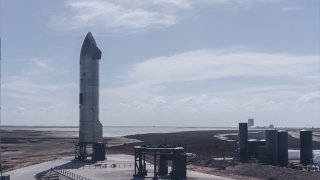
[This livestream has ended. A replay is available above.]
UPDATE: SpaceX appears to have lost Starship SN11 during the landing attempt.
Elon Musk's SpaceX is preparing to launch the latest prototype of its next-generation Starship rocket on Tuesday, in the second high-altitude flight test of the system this month.
Get South Florida local news, weather forecasts and entertainment stories to your inbox. Sign up for NBC South Florida newsletters.
Starship prototype rocket Serial Number 11, or SN11, will aim to launch and fly as high as 10 kilometers, or about 32,800 feet in altitude. The rocket is built of stainless steel, representing the early versions of the rocket that Musk unveiled in 2019.
The company is developing Starship with the goal of launching cargo and people on missions to the moon and Mars.
The SN11 flight will be similar to the ones SpaceX has conducted in the past four months, with the test flights of prototypes SN8, SN9, and SN10. While each of the prior rockets launched successfully and completed multiple development objectives, all three prototypes were explosively destroyed – SN8 and SN9 on impact during landing attempts, and SN10 a few minutes after landing.
Money Report
The FAA opened an investigation after the SN10 explosion, saying in a statement to CNBC "that issues related to the FAA mishap had no effect on public safety." The FAA approved modifications to SpaceX's launch license for SN11, with the company then authorized to conduct its next flight test.
Like its predecessors' flights, the goal of the SN11 launch is not necessarily to reach the maximum altitude, but rather to test several key parts of the Starship system. The Starship prototype stands at about 150 feet tall, or about the size of a 15-story building, and is powered by three Raptor rocket engines. SpaceX will fire all three engines for liftoff and then shut them down one at a time in sequence as it nears the top of the flight's intended altitude.
SN11 will aim to transfer propellant from its main tanks to the header tanks, and then flip itself for the "belly flop" reentry maneuver so it can control its descent through the air with the rocket's four flaps. Then, in the final moments of descent, SpaceX will flip return the rocket to a vertical orientation and fire the Raptor engines to slow itself down for a landing attempt.
Notably, SN11 launching on Friday would mark 24 days since SN10 flew, cutting nearly a week off the previous turnaround time as SpaceX ramps up manufacturing in Texas.
Starship is one of two "Manhattan Projects" that SpaceX is simultaneously developing, with the other being its Starlink satellite internet program. Musk has previously estimated that it will cost about $5 billion to fully develop Starship, although SpaceX has not disclosed how much it has spent on the program to date.
The company last month brought in $850 million in its latest capital fundraise at a $74 billion valuation.
Musk remains "highly confident" that Starship "will be safe enough for human transport by 2023″ – an ambitious goal given the company began the rocket's development and testing in earnest in early 2019.






